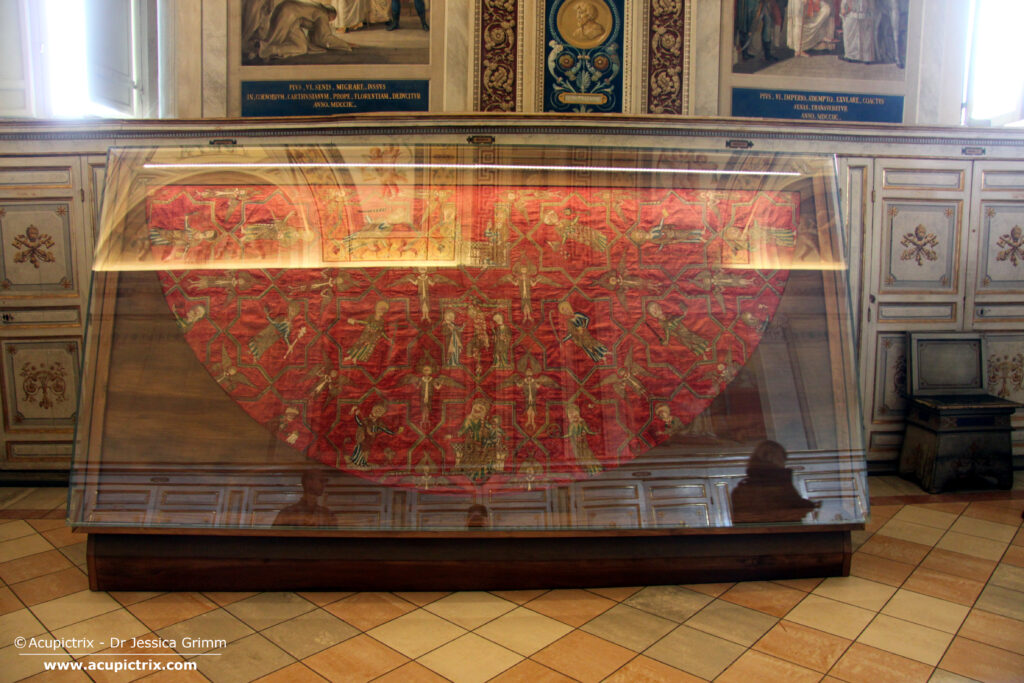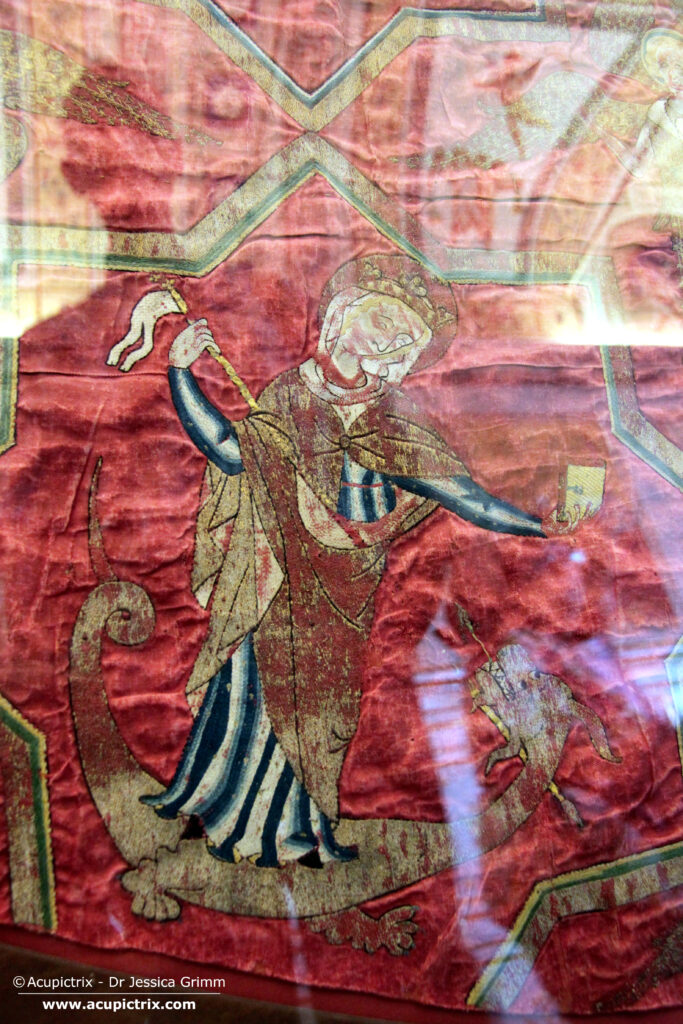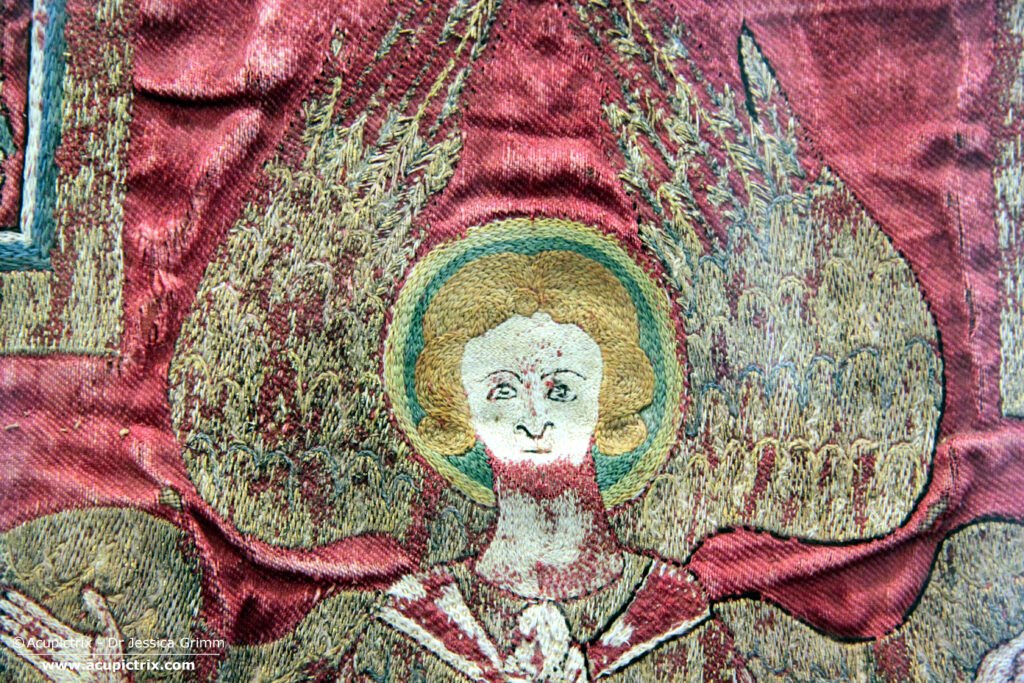Several Italian museums hold Opus anglicanum embroidered vestments. On the one hand, this is a testament to Opus anglicanum being hugely popular with European clergy in the 13th and 14th centuries. However, it was also the result of the Italians remaining Catholic and England going through the destructions of the Reformation. Some of these splendidly embroidered Opus anglicanum copes returned to London in 2016/2017 for the Opus anglicanum exhibition at the Victoria & Albert Museum. The late 13th century Vatican cope was one of them.

Visiting the Opus anglicanum Vatican Cope in the Musei Vaticani is not for the faint-hearted! It starts with getting your ticket. You have three options: 1) book your ticket way in advance on the museum’s website, 2) pay a premium to a booking agency at short notice, and 3) come ridiculously early and join the ridiculously long queue.
Unfortunately, you are not the only person visiting. Even more unfortunately, the Musei Vaticani lets in far more people than the buildings can handle. Almost all galleries are so crowded that you can’t get a good look at any of the priceless art on display. Lucky for us, the Vatican Cope is situated at the very end of the loop that lets you visit the Sixtine Chapel. It is even past the museum shops. However, it will take you about two hours to get there …
Once you have made it, you can take as many pictures as you like (without flash or tripod) of the beautiful Opus anglicanum embroidery. But it won’t be easy. The glass is reflective, and this gallery has many non-blinded windows, producing a nasty glare. Oh, and did I mention there is no caption or explanation of the priceless cope?

See what I mean? This detail of the Vatican cope shows you Saint Margaret and the dragon. The Opus anglicanum embroidery was made between AD 1280 and 1300 in England. The cope measures 143 x 315 cm. It would once have been larger, but it was cut down some time in its long history. The orphreys, the hood and the lower border are missing.
When worn centrally on the back of the wearer are three scenes. The Virgin and Child at the bottom, followed by the Crucifixion and the Coronation of the Virgin at the top. These principal scenes are surrounded by 11 Apostles, Saint Paul, Saint Stephen, Saint Lawrence, Catherine of Alexandria and Saint Margaret. The same depiction of a six-winged seraph occupies the areas between the scenes and saints.
As Saint Peter is depicted with his usual key and a papal tiara, the cope was likely a gift for, or made for, a pope. And although there are written records of a cope gifted by Edward I to Pope Nicholas IV in AD 1291 and another to Pope Boniface VIII in AD 1295, it is uncertain if either mentioned cope is this one. We do know that Pope Boniface VIII was fond of Opus anglicanum as he gifted his hometown Cathedral of Anagni several embroidered vestments.

The embroidery on the cope is executed on red silk twill reinforced with linen. The stitches used are characteristic of Opus anglicanum. The faces, hands, feet, hair and parts of the clothing are stitched in very fine directional split stitch. Some parts consist of laidwork with a trellis on top; see the ‘collar’ of the seraph in the picture above.
The golden parts are mainly stitched in underside couching. A single gold thread is couched down in a bricking or chevron pattern. The ends of the seraph’s wings are stitched in feathered underside couching. Simple golden stars are often added to those parts of the clothing that are stitched in silken split stitch. All in all, the embroidery on the Vatican Cope is rich in subtle variations.
Literature
Bentham, T., 2021. Opus Anglicanum: A practical guide. Crowood, Marlborough.
Browne, C., Davies, G., Michael, M.A. (Eds.), 2016. English Medieval Embroidery: Opus Anglicanum. Yale University Press, New Haven.
